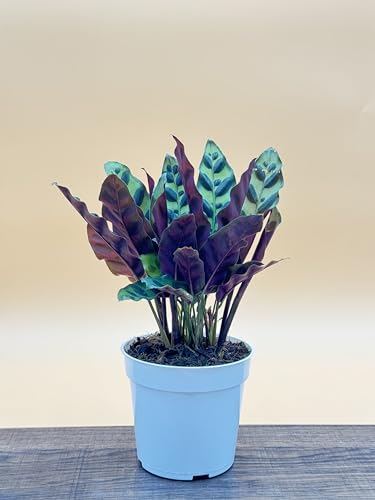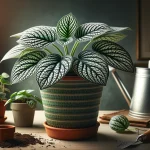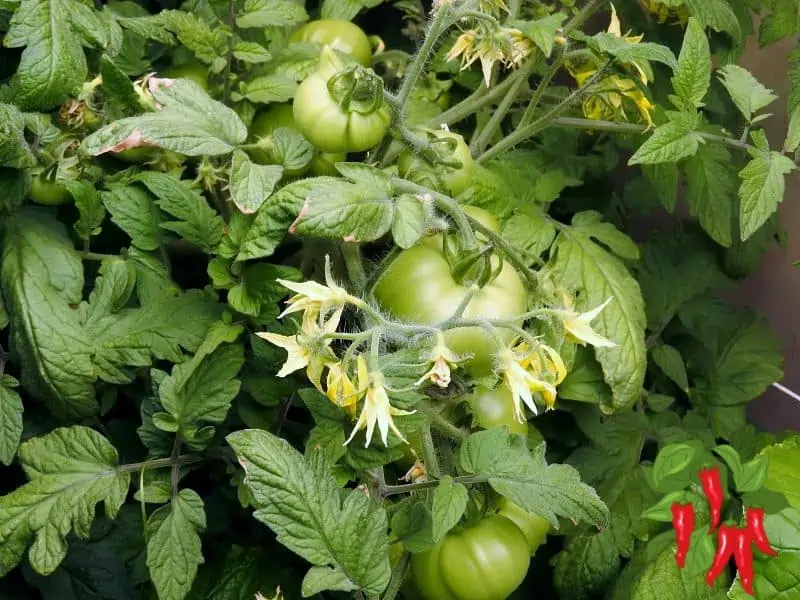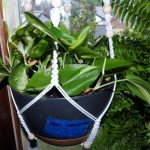This post may contain affiliate links. If you buy something from one of our links we may earn a commission. Thanks
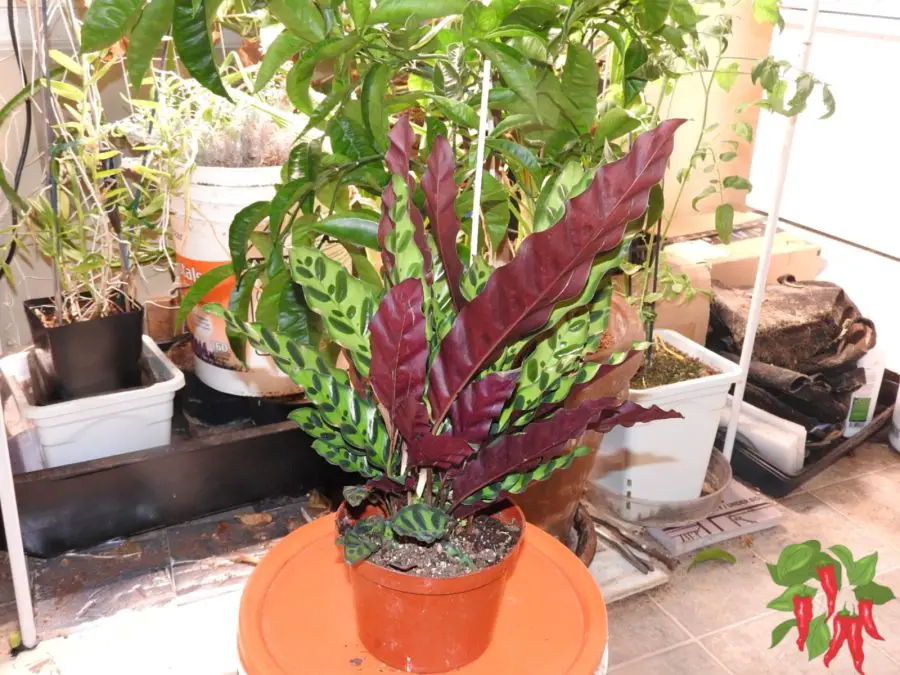
Caring For Rattlesnake Plant Introduction
Caring for Rattlesnake Plant can seem tricky at first, but with the right knowledge, it’s easier than you think.
These stunning tropical beauties, with their distinctive leaf patterns, can transform any space into a lush oasis.
Ready to become a Rattlesnake Plant pro? Let’s dive into the essential care tips that’ll help your Calathea lancifolia thrive!
Rattlesnake Plant Video
Rattlesnake Plant Care Key Takeaways
- Provide bright indirect light, high humidity (60-80%), and well-draining soil.
- Water when top inch of soil is dry, keeping soil moist but not soggy.
- Maintain temperatures between 65-80°F (18-27°C).
- Fertilize monthly during growing season.
- Prune yellow leaves and wipe dust from foliage regularly for optimal health.
Rattlesnake Plant Benefits
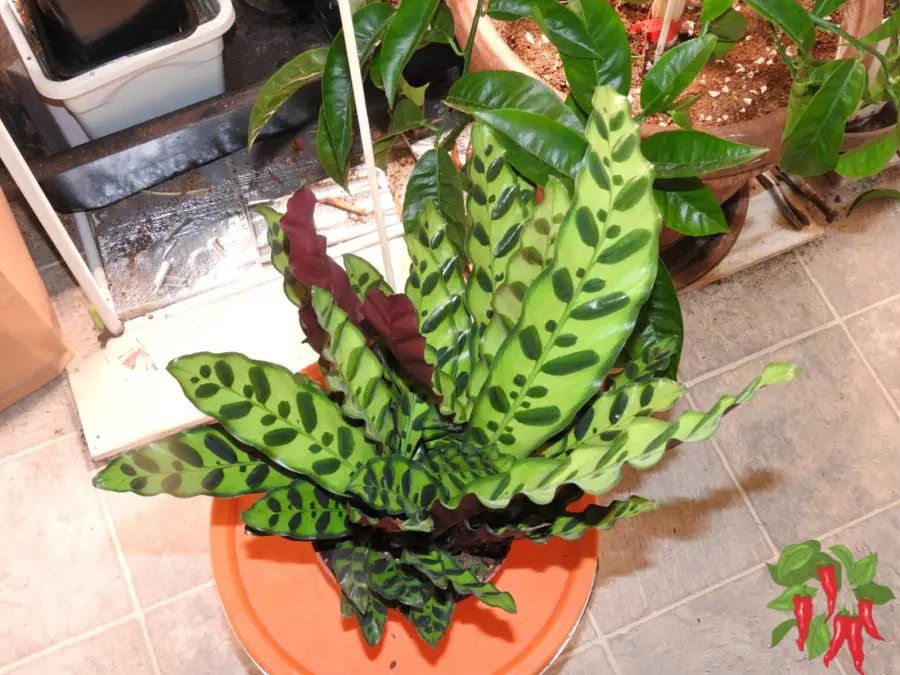
Rattlesnake Plants, also known as Calathea lancifolia, are more than just pretty faces. The rattlesnake plant was recently renamed Goeppertia insignia.
Goeppertia insignis (syn. Calathea lancifolia, Goeppertia lancifolia), the rattlesnake plant, is a species of flowering plant in the Marantaceae family, native to Rio de Janeiro state in Brazil.
It is an evergreen perennial, growing to 60–75 cm (24–30 in), with slender pale green leaves to 45 cm (18 in), heavily marked above with dark blotches, purple below. Wikipedia
These eye-catching houseplants offer several benefits:
1. Air purification: They help clean indoor air by removing toxins.
2. Humidity boost: Their large leaves increase humidity, benefiting both you and other plants.
3. Low maintenance: Once you understand their needs, they’re relatively easy to care for.
4. Unique appearance: Their distinctive leaf patterns make them a standout decor piece.
Rattlesnake Plant Light Requirements
Getting the light right is crucial for caring for Rattlesnake Plant indoors. These tropical beauties prefer:
- Bright, indirect light
- No direct sunlight, which can scorch their leaves
- A spot near an east or north-facing window is ideal
- If light is low, consider using artificial grow lights
For outdoor care, place them in a shaded area with dappled sunlight.
Rattlesnake Plant Soil (Coco Coir and Perlite)
Creating the perfect soil mix is crucial for rattlesnake plant care. These tropical beauties thrive in a well-draining, moisture-retentive medium that mimics their natural habitat.
Let’s dive into the ideal soil composition and why it works so well:
1. Coco Coir
Coco coir, made from coconut husks, is an excellent base for your rattlesnake plant soil:
- Retains moisture well without becoming waterlogged
- Provides good aeration for roots
- Environmentally friendly and sustainable
- Naturally resistant to fungal growth
2. Perlite
Perlite, a volcanic glass that’s been expanded with heat, is a crucial component:
- Improves drainage and prevents soil compaction
- Increases air circulation around the roots
- Lightweight and easy to mix
Ideal Ratio:
Mix equal parts coco coir and perlite for a balanced, well-draining soil.
3. Additional Components
To further enhance your soil mix, consider adding:
- Orchid bark: Improves drainage and mimics the plant’s natural environment
- Activated charcoal: Helps filter impurities and prevent odors
- Worm castings: Provides slow-release nutrients
Creating Your Mix:
1. Combine 2 parts coco coir, 2 parts perlite, 1 part orchid bark
2. Add a small amount of activated charcoal and worm castings
3. Mix thoroughly until well combined
pH Level:
Aim for a slightly acidic to neutral pH between 6.0 and 7.0.
Pot Selection:
Choose a pot with drainage holes to prevent water from sitting at the bottom.
Why This Mix Works:
- Retains enough moisture to keep the plant hydrated
- Allows excess water to drain quickly, preventing root rot
- Provides ample aeration for healthy root growth
- Mimics the loose, organic-rich soil of the plant’s natural habitat
Avoid These Common Mistakes:
- Using heavy, compacted potting soils or garden soil
- Adding too much water-retentive material like peat moss
- Forgetting to include components for drainage
Maintenance:
- Replace the soil mix every 1-2 years when repotting
- If the soil becomes compacted over time, gently aerate it with a chopstick
By providing your Rattlesnake Plant with this ideal soil mix, you’re setting the stage for healthy growth and vibrant foliage. Remember, good soil is the foundation of successful rattlesnake plant care indoors!
Rattlesnake Plant Watering
Proper watering is key to Calathea rattlesnake plant care. These tropical beauties can be a bit finicky when it comes to their water needs, but once you understand their preferences, you’ll be well on your way to nurturing a thriving plant.
Rattlesnake Plants, like many Calatheas, prefer consistently moist soil without becoming waterlogged. Striking this balance is crucial for their health and vitality.
The watering routine for your Rattlesnake Plant can significantly impact its overall well-being.
Underwatering can lead to crispy, brown leaf edges and drooping, while overwatering can cause root rot and yellowing leaves.
By mastering the art of watering, you’ll not only prevent these issues but also promote lush growth and vibrant foliage.
When caring for Rattlesnake Plant indoors, it’s important to consider factors like humidity, temperature, and light exposure, as these can all affect how quickly your plant uses water.
Additionally, seasonal changes may require adjustments to your watering schedule. Proper watering is key to Calathea rattlesnake plant care.
Here’s what to remember when watering your Rattlesnake Plant:
- Keep soil consistently moist but not soggy
- Water when the top inch of soil feels dry
- Use room temperature, filtered water if possible
- Reduce watering in winter when growth slows
Rattlesnake Plant Humidity and Temperature
Creating the perfect environment for your Rattlesnake Plant is like crafting a mini tropical oasis in your home.
These stunning plants, native to the warm, humid forests of Brazil, thrive when their surroundings mimic their natural habitat.
Humidity and temperature play crucial roles in rattlesnake plant care, directly impacting leaf health, growth rate, and overall vitality.
Get these factors right, and you’ll be rewarded with lush, vibrant foliage that showcases the plant’s distinctive patterns.
Let’s dive into the specifics of how to provide the ideal climate for your Calathea lancifolia, ensuring it not only survives but truly thrives in your care.
High humidity is crucial for rattlesnake plant care indoors:
- Aim for 60-80% humidity
- Use a pebble tray, humidifier, or regular misting to increase moisture
- Group with other plants to create a humid microclimate
- Keep temperatures between 65-80°F (18-27°C)
- Avoid cold drafts and sudden temperature changes
Rattlesnake Plant Propagation
Propagating your Rattlesnake Plant (Calathea lancifolia) is an exciting way to expand your collection or share these beautiful plants with friends.
While Calatheas can be a bit trickier to propagate than some other houseplants, with patience and the right technique, you can successfully create new plants.
Here are two main methods for propagation:
1. Division Method
This is the most reliable method for propagating Rattlesnake Plants:
Steps:
a. Prepare materials: Have fresh potting soil, clean pots, and sterile cutting tools ready.
b. Remove from pot: Gently remove the plant from its pot, being careful not to damage the roots.
c. Separate roots: Carefully untangle the roots and look for natural separation points.
d. Divide the plant: Using clean, sharp scissors or a knife, separate the root ball into smaller sections. Ensure each section has healthy roots and at least 2-3 leaves.
e. Replant: Place each division in a pot with fresh, well-draining soil. The pot should be just large enough to accommodate the roots.
f. Water and care: Water thoroughly and place in a warm, humid spot with indirect light. Treat as you would a mature plant, but be extra attentive to its needs as it establishes.
Best time:
Spring or early summer, when the plant is actively growing.
Tips:
- Ensure each division is a good size – too small divisions may struggle to survive.
- Use a rooting hormone on the cut roots to encourage new growth.
- Maintain high humidity around new divisions to reduce transplant shock.
2. Stem Cuttings
While less common and potentially more challenging, stem cuttings can be successful:
Steps:
a. Select a stem: Choose a healthy stem with at least two leaves. The stem should be at least 4 inches long.
b. Make the cut: Using clean, sharp scissors, cut the stem just below a leaf node (where a leaf attaches to the stem).
c. Prepare cutting: Remove the lower leaf, leaving the top 1-2 leaves intact.
d. Rooting medium: You can root the cutting in water or moist soil.
– For water: Place the cutting in a clear container with room temperature water. Change water every few days.
– For soil: Plant the cutting in moist, well-draining soil. Cover with a clear plastic bag to maintain humidity.
e. Provide warmth and light: Keep the cutting in a warm place with bright, indirect light.
f. Wait for roots: This can take several weeks. Look for new growth as a sign of successful rooting.
g. Transplant: Once roots are 1-2 inches long, transplant water-rooted cuttings to soil. For soil-rooted cuttings, gradually remove the plastic cover.
Best time:
Late spring to early summer, when the plant is actively growing.
Tips:
- Use a rooting hormone to increase the chances of successful rooting.
- Maintain high humidity around the cutting.
- Be patient – Calathea cuttings can take longer to root than many other plants.
General Propagation Tips:
1. Hygiene: Always use clean, sterilized tools to prevent disease transmission.
2. Environment: Provide a warm, humid environment for new propagations.
3. Patience: Rattlesnake Plants can be slow to show new growth after propagation.
4. Care: Treat new propagations gently, as they’re more sensitive than established plants.
5. Monitoring: Keep a close eye on new plants for signs of stress or disease.
By mastering these propagation techniques, you can expand your Rattlesnake Plant collection and share the beauty of these stunning plants with others.
Remember, each propagation attempt is a learning experience, so don’t be discouraged if your first try isn’t successful.
With practice and patience, you’ll soon be growing new Calathea lancifolia plants with confidence!
Repotting Rattlesnake Plants
Knowing when and how to repot is an important rattlesnake plant care tip. Proper repotting ensures your Calathea lancifolia has enough space to grow and access to fresh nutrients, promoting healthy development and vibrant foliage.
When to Repot:
Repot every 1-2 years or when rootbound.Signs of being rootbound include:
- Roots growing out of drainage holes
- Plant drying out quickly despite regular watering
- Stunted growth or yellowing leaves
- Pot feels light when lifted
Choosing the Right Pot:
- Select a pot 1-2 inches larger than the current one
- Ensure the new pot has adequate drainage holes
- Consider using terracotta pots for better moisture regulation
Best Time for Repotting:
- Spring is the ideal time for repotting
- This coincides with the start of the growing season
- Avoid repotting during winter when the plant is dormant
Repotting Process:
1. Prepare your workspace and gather materials
2. Gently remove the plant from its current pot
3. Inspect the roots and trim any that are dead or rotting
4. Tease out compacted roots to encourage new growth
5. Place a layer of fresh soil in the new pot
6. Position the plant in the center of the new pot
7. Fill in around the roots with fresh soil, tamping lightly
8. Leave about an inch of space at the top for watering
Soil Mix:
- Use a fresh, well-draining soil mix
- A mixture of coco coir, perlite, and orchid bark works well
- Add a small amount of compost or worm castings for nutrients
Post-Repotting Care:
- Water thoroughly after repotting
- Place the plant in a shaded area for a few days to recover
- Avoid fertilizing for about a month to prevent root burn
- Monitor the plant closely for signs of stress
Additional Tips:
- Clean and sterilize pots before reusing them
- If your plant is particularly large, consider dividing it during repotting
- Be gentle with the roots to minimize transplant shock
By following these detailed repotting guidelines, you’ll ensure your Rattlesnake Plant has the space and nutrients it needs to thrive.
Remember, a little extra care during the repotting process goes a long way in maintaining the health and beauty of your Calathea lancifolia.
Rattlesnake Plant Problems
Even with the best care, issues can arise with your Calathea lancifolia. Being able to identify and address these problems quickly is crucial for maintaining a healthy plant.
Here are some common problems you might encounter and their solutions:
1. Brown Leaf Edges
Cause:
- Low humidity: Rattlesnake Plants thrive in high humidity environments.
- Tap water with high mineral content: These plants are sensitive to chemicals in water.
- Excessive fertilization: Over-fertilizing can burn the leaf edges.
Solution:
- Increase humidity: Use a humidifier, pebble tray, or group plants together.
- Use filtered water: Switch to distilled, rainwater, or filtered water for watering.
- Adjust fertilization: Reduce frequency or dilute fertilizer strength.
- Trim affected leaves: Remove severely damaged leaves to encourage new growth.
2. Pest Infestations
Common pests:
- Spider mites: Tiny arachnids that cause stippling on leaves.
- Mealybugs: Small, white, cottony insects that cluster on stems and leaves.
- Scale insects: Small, oval-shaped bugs that attach to stems and leaves.
Solution:
- Isolate affected plants: Prevent spread to other houseplants.
- Wipe leaves: Use a soft cloth with neem oil solution or insecticidal soap.
- Prune heavily infested areas: Remove and dispose of severely affected parts.
- Use systemic insecticide: For severe infestations, consider a systemic treatment.
- Improve plant health: Stressed plants are more susceptible to pests.
3. Root Rot
Cause:
- Overwatering: Consistently soggy soil leads to root decay.
- Poor drainage: Inadequate drainage in soil or pot traps excess water.
Solution:
- Adjust watering habits: Allow top inch of soil to dry between waterings.
- Ensure well-draining soil: Use a mix with perlite or orchid bark for better drainage.
- Check pot drainage: Ensure pot has adequate drainage holes.
- Repot if necessary: Remove affected roots and repot in fresh, dry soil.
- Treat with fungicide: Apply a fungicide if root rot is caught early.
4. Yellowing Leaves
Cause:
- Overwatering or underwatering
- Nutrient deficiency
- Excessive direct sunlight
Solution:
- Adjust watering: Maintain consistent moisture without waterlogging.
- Check nutrient levels: Fertilize monthly during growing season.
- Adjust light: Move to a spot with bright, indirect light.
5. Curling Leaves
Cause:
- Low humidity
- Temperature stress
- Pest infestation
Solution:
- Increase humidity: Mist leaves or use a humidifier.
- Maintain stable temperature: Keep away from drafts and heat sources.
- Check for pests: Inspect plant thoroughly and treat if necessary.
6. Fading Leaf Patterns
Cause:
- Too much direct sunlight
- Aging leaves
Solution:
- Adjust light: Move to a spot with bright, indirect light.
- Prune old leaves: Remove older leaves to encourage new growth.
7. Drooping or Wilting
Cause:
- Underwatering
- Overwatering
- Temperature stress
Solution:
- Check soil moisture: Water if too dry, or allow to dry if overwatered.
- Adjust temperature: Keep between 65-80°F (18-27°C).
- Increase humidity: Use a humidifier or pebble tray.
Remember, prevention is often the best cure. Regular monitoring, proper care, and quick action when issues arise will help keep your Rattlesnake Plant healthy and vibrant.
If problems persist despite your best efforts, don’t hesitate to consult with a local plant expert or nursery for personalized advice.
Rattlesnake Plant Care FAQs
Curious about the finer points of rattlesnake plant care? Here are answers to some frequently asked questions to help you become a Calathea lancifolia expert:
Q: How much sun does a rattlesnake plant need?
A: Rattlesnake plants thrive in bright, indirect light. Avoid direct sunlight as it can scorch the leaves.
Q: How often should you water a rattlesnake plant?
A: Water when the top inch of soil feels dry. This usually means once or twice a week, but frequency may vary based on your home’s conditions.
Q: Should you mist a rattlesnake plant?
A: Yes, misting can help increase humidity, which rattlesnake plants love. However, it shouldn’t replace proper watering.
Q: Do rattlesnake plants like big pots?
A: Not particularly. They prefer to be slightly rootbound, so choose a pot that’s only 1-2 inches larger than the current one when repotting.
Q: Do rattlesnake plants like to be root bound?
A: They don’t mind being slightly rootbound, but don’t let them get too cramped as it can stunt growth.
Q: When should you repot a rattlesnake plant?
A: Repot every 1-2 years in spring, or when you notice roots growing out of the drainage holes.
Q: Are rattlesnake plants hard to keep alive?
A: They can be a bit fussy about humidity and water quality, but once you understand their needs, they’re not too difficult to care for.
Q: What does an overwatered rattlesnake plant look like?
A: Signs include yellowing leaves, soggy soil, and a generally droopy appearance. The plant may also develop root rot if overwatering continues.
Q: How do you encourage new growth on a rattlesnake plant?
A: Provide optimal care conditions, prune old or damaged leaves, and fertilize monthly during the growing season.
Q: Where do you put a rattlesnake plant?
A: Place it in a spot with bright, indirect light, away from drafts and heat sources. Near an east or north-facing window is often ideal.
Q: Can I put my rattlesnake plant outside?
A: You can move it outdoors during warm months, but place it in a shaded area and bring it back inside when temperatures drop below 60°F (15°C).
Q: How do I keep my rattlesnake plant happy?
A: Provide bright indirect light, high humidity, consistent moisture (but not soggy soil), and protect it from temperature extremes and drafts.
Caring For Rattlesnake Plant Conclusion
Mastering the art of caring for Rattlesnake Plant can be incredibly rewarding. With their stunning foliage and air-purifying qualities, these tropical beauties are well worth the effort.
Remember, every plant is unique, so don’t be afraid to adjust your care routine based on your specific plant’s needs and your home environment.
Caring For Rattlesnake Plant Key Takeaways
- Provide bright, indirect light
- Maintain high humidity (60-80%)
- Use well-draining soil mix
- Water when top inch of soil is dry
- Keep temperatures between 65-80°F (18-27°C)
- Fertilize monthly during growing season
- Repot every 1-2 years in spring
- Monitor for pests and yellowing leaves
- Adjust care based on your plant’s response
By following these rattlesnake plant care tips, you’ll be well on your way to nurturing a thriving, beautiful Calathea lancifolia. Happy growing!
Learn more: Indoor Apartment Gardening: 15 Point Comprehensive Guide
See Rattlesnake Plants on Amazon
More Related Subtopics
Calathea Varieties
While the Rattlesnake Plant (Calathea lancifolia) is a stunner, there are many other beautiful Calathea species to explore:
1. Calathea orbifolia: Known for its large, round leaves with silvery stripes.
2. Calathea makoyana (Peacock Plant): Features oval leaves with dark green borders and intricate patterns.
3. Calathea zebrina (Zebra Plant): Recognized by its velvety leaves with bold, dark green stripes.
4. Calathea ornata (Pinstripe Plant): Characterized by its pink pinstripe pattern on dark green leaves.
These varieties share similar care requirements, making them great companions for your Rattlesnake Plant.
Tropical Plant Care
Many tropical houseplants share care needs with the Rattlesnake Plant. Here are some tips for caring for tropical plants:
1. Humidity: Most tropical plants thrive in high humidity. Use humidifiers, pebble trays, or group plants together to increase moisture.
2. Light: Many prefer bright, indirect light. Avoid harsh direct sunlight.
3. Water: Keep soil consistently moist but not waterlogged. Use room temperature water.
4. Temperature: Maintain warm temperatures between 65-80°F (18-27°C).
5. Soil: Use well-draining, nutrient-rich potting mixes.
6. Fertilizer: Feed regularly during the growing season with a balanced, water-soluble fertilizer.
Indoor Jungle Creation
Incorporating Rattlesnake Plants into a lush indoor display can create a stunning tropical oasis:
1. Layering: Place taller plants like Monstera or Fiddle Leaf Fig behind your Rattlesnake Plant, with shorter plants in front.
2. Grouping: Cluster plants with similar care needs together. This not only looks great but also increases humidity.
3. Varied textures: Mix plants with different leaf shapes and textures for visual interest.
4. Plant stands: Use stands of varying heights to create depth and maximize space.
5. Natural elements: Incorporate natural materials like wood, stone, or woven baskets as planters.
6. Hanging plants: Add dimension by including hanging plants like pothos or string of pearls.
7. Accent pieces: Use decorative elements like driftwood, crystals, or small figurines to enhance the jungle feel.
Remember to consider each plant’s light and care needs when creating your indoor jungle.
With some creativity and care, you can transform your space into a lush, tropical paradise with your Rattlesnake Plant as a centerpiece.


